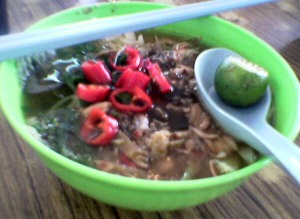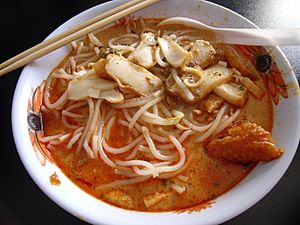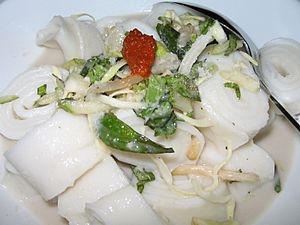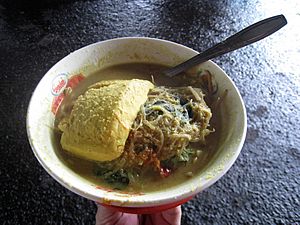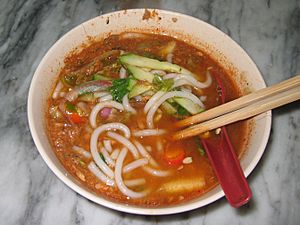Laksa facts for kids
Laksa is a very popular and spicy noodle soup from the Peranakan culture. It's a mix of Chinese and Malay traditions. Curry laksa is a creamy soup made with coconut milk, often including prawns, beef, bean sprouts, and chili. It can be quite spicy, but you can make it milder by using less chili.
Laksa is a favorite food in Malaysia. A famous type called Asam Laksa can be found in Air Itam, Penang.
Contents
Types of Laksa
Laksa comes in different types, mainly based on its soup. The soup can be rich and savory with coconut milk, or fresh and sour with asam (like tamarind). Sometimes, it's a mix of both!
There are two main kinds of laksa: curry laksa and asam laksa. Curry laksa uses a coconut milk curry soup with noodles. Asam laksa is a sour soup, usually made with tamarind.
Most often, thick rice noodles called laksa noodles are used. But sometimes, thin rice vermicelli (called bee hoon) is also popular. Some recipes even use other noodles, like spaghetti in Johor laksa, or even Japanese udon noodles in modern versions.
Curry Laksa
Curry laksa is a creamy, coconut milk-based curry soup. It often includes ingredients like bean curd puffs, fish sticks, shrimp, and cockles. Some places also serve it with chicken.
Laksa is usually served with a spoonful of sambal (chili paste). It's often topped with Vietnamese coriander, also known as laksa leaf or daun kesum in Malay.
In Penang, this dish is often called curry mee because it uses different noodles (yellow mee or bee hoon).
The name "curry laksa" is more common in Kuala Lumpur and Singapore. Laksa is very popular in Singapore. You can have it plain with just noodles and gravy, or with extra ingredients. Singaporean curry laksa was even ranked among the world's best foods!
New versions of curry laksa are also appearing. These include laksa yong tau foo (stuffed tofu in laksa) and even fancy lobster laksa.
In Indonesia, most laksa types use coconut milk soup. Common spices are turmeric, coriander, candlenut, lemongrass, garlic, shallot, and pepper. These are cooked in coconut milk. Indonesian lemon basil leaf (daun kemangi) is often used instead of daun kesum. Thin rice vermicelli is common, and some recipes add slices of ketupat or lontong (rice cakes). Bogor laksa even uses ground oncom (a fermented bean cake) in its soup.
Laksa Lemak
Laksa lemak, also known as nyonya laksa, is a type of laksa with a very rich coconut gravy. The word lemak in Malay means the richness that coconut milk adds to a dish. This laksa is made with a rich, slightly sweet, and strongly spiced coconut gravy. It usually has a fish-based gravy, and it's quite similar to Thai laksa.
Laksam
Laksam is a special dish from the northeastern Malaysian states of Kelantan, Terengganu, and Kedah. It uses very thick, flat white rice flour noodles. These noodles are served in a rich, white gravy made from boiled fish and coconut milk. Sometimes, it's even made with eels. People traditionally eat Laksam with their hands because the gravy is so thick.
Katong Laksa
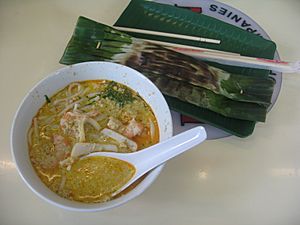
Katong laksa is a type of laksa lemak from the Katong area of Singapore. What's special about Katong laksa is that the noodles are usually cut into smaller pieces. This way, you can eat the whole dish with just a spoon, without needing chopsticks or a fork.
Bogor Laksa
Bogor Laksa is a very famous type of Laksa from Bogor city in West Java, Indonesia. Its thick, yellowish coconut milk soup is made from a mix of shallots, garlic, candlenut, turmeric, coriander, lemongrass, and salt. Bogor laksa has a unique earthy and nutty taste from oncom (an orange fermented bean cake, similar to tempe).
The hot soup is poured over a bowl of bihun (rice vermicelli), ketupat (glutinous rice cake), smashed oncom, tauge (bean sprouts), kemangi (basil leaves), yellow tofu, and boiled egg. All these ingredients become soft and cooked in the hot soup. Real Bogor laksa also includes shredded chicken and dried prawns. Cheaper versions found on the street are often vegetarian, using oncom as a meat substitute. It's usually served with sambal cuka (chili in vinegar).
Cibinong Laksa
Cibinong Laksa comes from Cibinong, a town near Bogor. It's similar to Bogor laksa but does not have oncom. The soup is a yellowish coconut milk with various spices. It's served with bean sprouts, rice vermicelli, hard-boiled eggs, shredded chicken, fried shallots, and lots of Indonesian lemon-basil leaves. Sometimes, rice cakes (ketupat or lontong) are added too.
Betawi Laksa
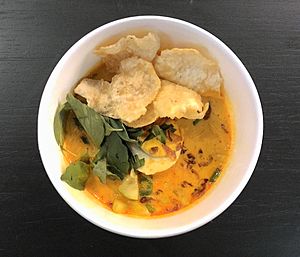
Betawi Laksa is a type of laksa from Jakarta, Indonesia. Its thick, yellowish coconut milk soup is made with shallots, garlic, turmeric, galangal, lemongrass, salam leaf, kaffir lime leaf, ginger, and pepper. It also has ground rebon (dried small shrimp) for a special taste. The dish includes ketupat (rice cake), tauge (bean sprouts), kemangi (Indonesian lemon-basil leaf), and boiled egg. It's topped with bawang goreng (fried shallots) and often emping crackers.
Tangerang Laksa
Tangerang Laksa is a Chinese-Indonesian type of laksa from Tangerang town, west of Jakarta. The main parts of Tangerang laksa are homemade rice noodles that look like spaghetti, chicken stock, mung beans, potatoes, and chives. You can choose to have it with a boiled egg or roasted chicken. The soup is a thick, yellowish coconut milk made with ground shallots, garlic, turmeric, galangal, coriander, salam (Indonesian bayleaf), ginger, and white peppercorn powder. It has shredded chicken, rice vermicelli, diced boiled potatoes, boiled mung beans, chopped scallions, and serundeng (sautéed grated coconut) to make it thicker. Tangerang laksa is liked for its balanced coconut milk soup, which is not too thick or too watery.
Palembang Laksan
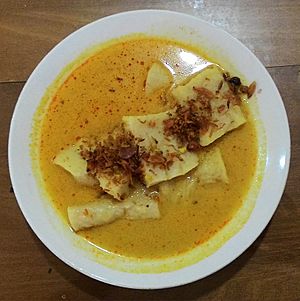
Palembang Laksan is a special dish from Palembang, South Sumatra. It's often called pempek (fishcake) served in laksa soup. It has slices of pempek or surimi fishcake in a coconut milk-shrimp broth soup with spices, topped with fried shallots.
Palembang Lakso
Palembang Lakso is another style of laksa from Palembang. Unlike Laksan, which uses fishcake slices, Lakso uses noodle-like steamed sago paste. This is served in a coconut milk soup with a mix of spices like palm sugar, black pepper, turmeric, coriander, and candlenut. It's sprinkled with fried shallots. Palembang Lakso usually uses freshwater fish like patin and gabus (snakehead fish) for its soup base and fish meat. Simpler versions might just use instant chicken broth.
Banjar Laksa
Banjar Laksa is from Banjarmasin in South Kalimantan. It uses ikan haruan (snakehead fish) as one of its ingredients. Like Palembang Lakso, instead of rice noodles, Banjar laksa uses steamed noodle-like balls made from rice flour paste. These are served in a thick, yellowish soup made from coconut milk, ground spices, and snakehead fish broth. Fried shallots and hard-boiled duck eggs might be added on top.
Thai Laksa
Thai Laksa is a common dish in Southern Thailand. It's likely influenced by Malaysia's laksa lemak or curry laksa. Thai laksa uses red curry paste, chicken broth, and coconut milk, so it's a type of curry laksa. It also has some similarities to Thai tom yum goong, with lots of lemongrass, prawns, and mushrooms. Thai laksa uses rice noodles, garlic, lemongrass, ginger, red curry paste, chicken stock, soy sauce, sugar, coconut milk, prawns, mushrooms, spinach, lime juice, coriander, and onions.
Asam Laksa
Asam laksa is a sour soup made with fish and tamarind. Penang Asam Laksa was even listed as one of the world's most delicious foods! Asam is a Malay word for any ingredient that makes a dish taste sour, like tamarind or gelugur. Laksa often uses asam keping, which are dried slices of a sour fruit.
The main ingredients for asam laksa include shredded fish (usually a small mackerel), and finely sliced vegetables. These include cucumber, onions, red chilies, pineapple, lettuce, common mint, daun kesum (Vietnamese mint), and pink bunga kantan (torch ginger). Asam laksa is usually served with thick or thin rice noodles. It's often topped with petis udang or "hae ko," which is a thick, sweet prawn paste.
Images for kids
-
Laksa Johor is notable for its use of cooked spaghetti.
-
A typical bowl of Katong Laksa in Singapore.
See also
 In Spanish: Laksa para niños
In Spanish: Laksa para niños


